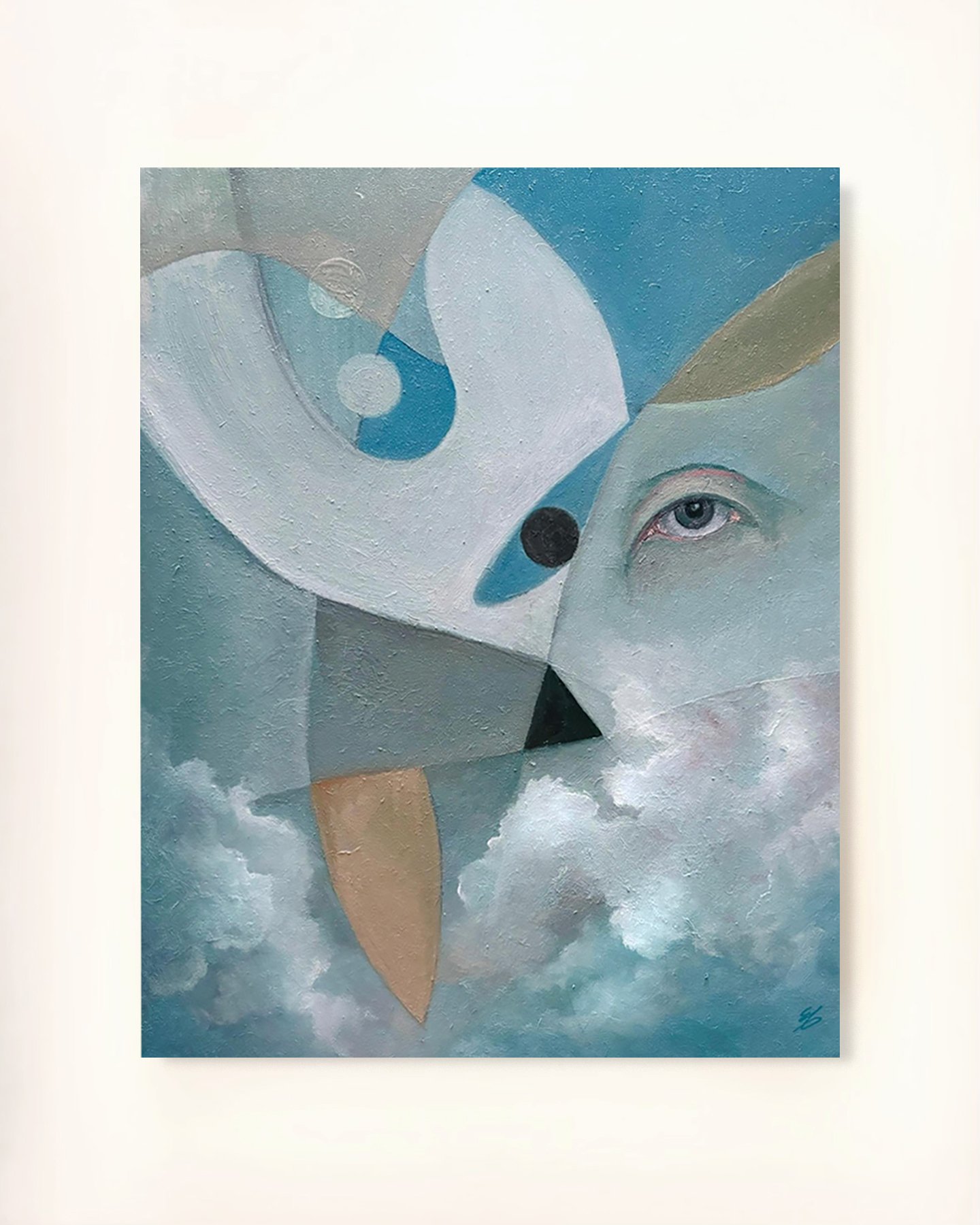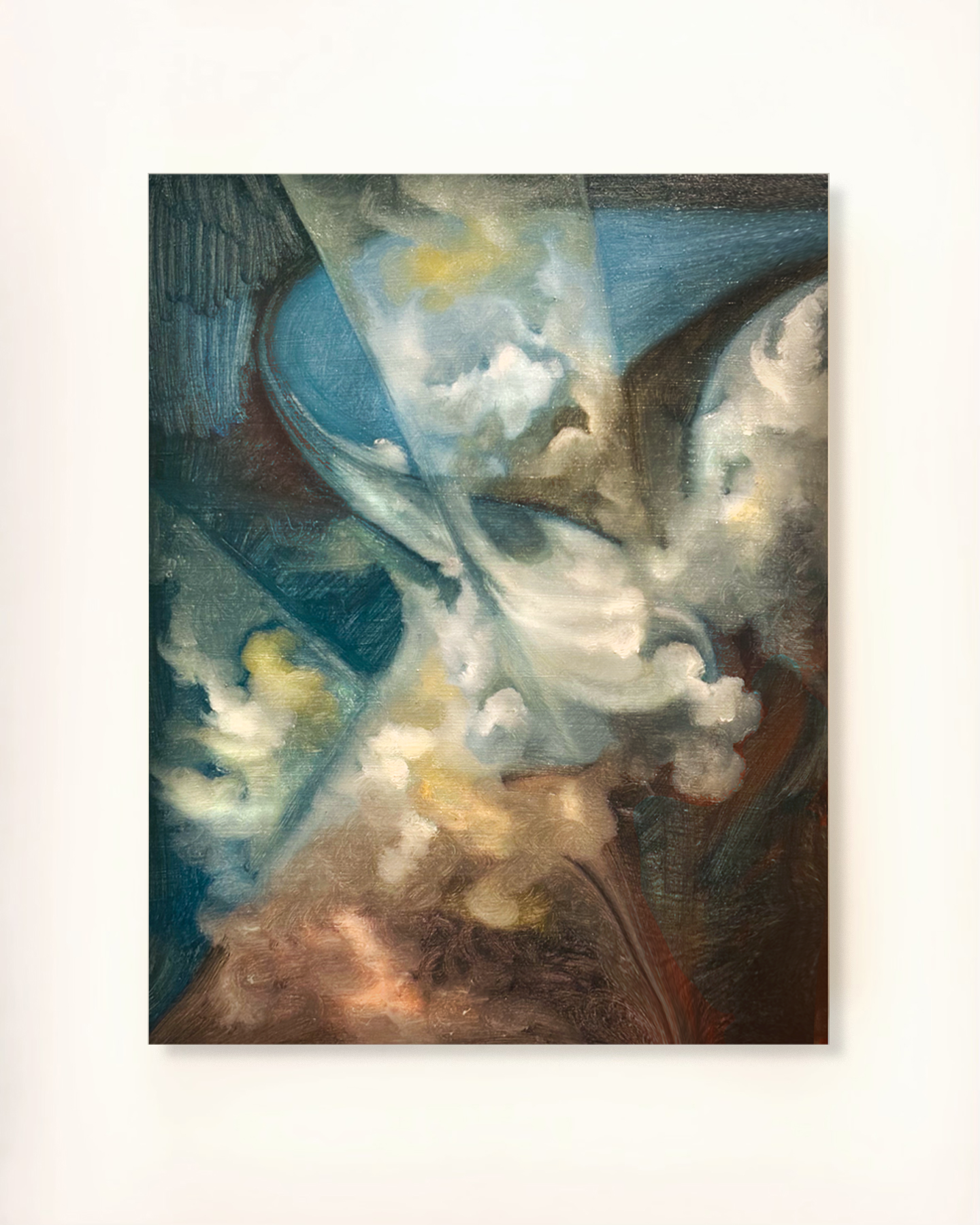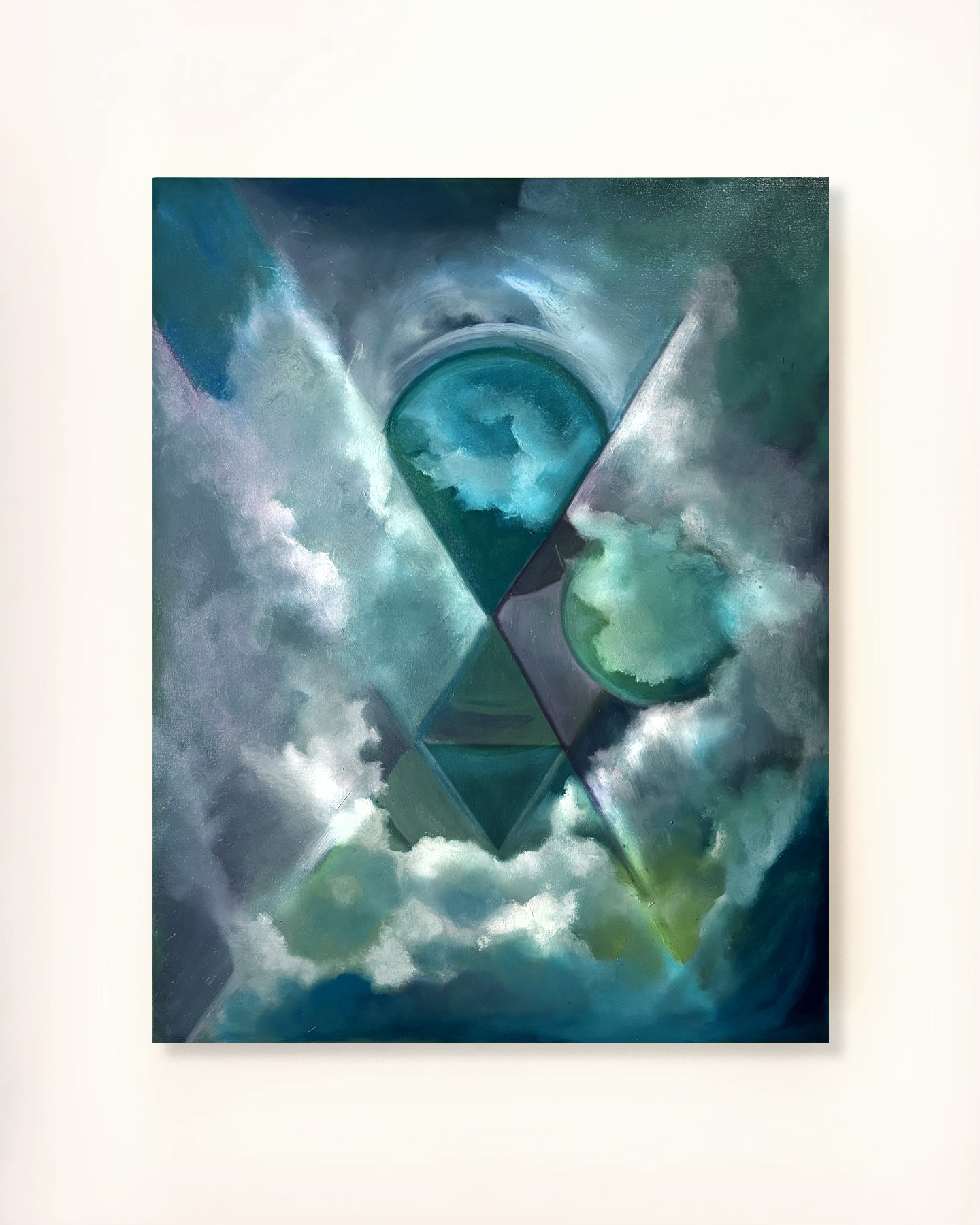Ellen Frances | June, 2024 | Tönnheim Gallery, Madrid, Spain
C H A O S T H E O R Y
1.618
1.618
x n + 1 = r x n ( 1 − x n )
• •
x n + 1 = r x n ( 1 − x n ) • •
E = mc²
E = mc²
In the summer of 2021 I rented a room, by chance, in the 18th c. home of a Taiwanese artist and ancient geometry scholar. It was there, along the Hudson River, beside a 25 acre friary of The Capuchin Order, that I witnessed a quiet dedication to the study of sacred geometry’s presence in art and nature. Upon my return to New York City that fall, I began to study patterns in music, movement and painting. I discovered Dali’s obsession with “Nuclear Mysticism”, post WWII. This period saw Dali return to his Roman Catholic roots via the geometric harmonies of religious iconography. His work of this era drew a direct visual correlation to the mathematical and scientific underpinnings of Einstein’s atomic theory – Thus concluding that the atom, as the basic building block of matter, held spiritual significance which could be visualized precisely via geometry. – Further readings included an examination of W.B. Yeats's affiliation with the secret society; The Hermetic Order of The Golden Dawn. In seminal hermetic-inspired works such as "A Vision," (1925) Yeats employs geometric diagrams as conduits for spiritual revelation. Additionally, writings and illustrations authored by Newton and DaVinci (among others) served as vehicles of understanding for a complex mathematical world. It is a world which I am academically unqualified to decipher, but am enthralled by from a mystical and theoretical perspective.
Rooted in a search for alchemical clarity via the study and practice of unlimited self expression, my work is a combination of automatic writing, sketching, hand-sewing, painting, and theatricality. Often described as visually surreal; the imperfect, classical approach I take is a commentary on the beauty of the human spirit’s presence in craft. It is also a defiant rebellion against present-day artificial generative evolution, which suppresses our innate ability to imagine freely in an increasingly algorithmic, mathematically flattened world.
A R T I S T S T A T E M E N T
© _ // - ™
© _ // - ™
†
----
† ----
READ FULL ARTIST STATEMENT:
-
Sacred Geometry: Growing up in a Roman Catholic household, the mysterious iconography and symbolism of religious artwork has resonated with me deeply from the onset of my earliest memory. My fascination with the symbolic lexicon extended to the illustrative work of fraternal orders such as Freemasonry; embraced by my favorite luminaries like Newton and Mozart. It was not until recently, however, that the nexus between my interest in mystical subject matter and my comprehension of mathematical breakdown came into focus with discernible clarity.
My interests in harmony, supported by the theory of the divine in sacred geometry, fuels much of my inquisition into higher modes of cogitation. Yet, in juxtaposition, I find profound aesthetic merit in the deliberate deconstruction of harmonious compositions. A poignant illustration of this is exemplified by the famous comparative analysis of Picasso's "Study for Guitar Sculpture" (1924) and Albrecht Dürer's "Sacred Geometry" (1528). While both are centered on the motif of the guitar, these works display disparate, albeit equally resonant, aesthetic frequencies. Picasso’s signature deconstruction of form portrays a visual and theoretical chaotic fragmentation akin to the division of particles. -
Birthed from Chaos: I have traced all mystical and spiritual uses for sacred geometric iconography back to ancient civilization when seeking to understand various realms of existence. Records reveal all mystical icons and human awareness of sacred geometry are derived from Egyptology and the dawn of man. Nature’s "divine" engineering proves existence is, fundamentally, harmonious formation. However, when going back further in time beyond “birth”, to pre-existence, it seems inevitable we would discover harmony’s deconstructed state. We would find such symmetrical harmony is born from chaos. Chaos theory reveals that even within the visible randomness of complex, chaotic systems, there are inherent repetitions, patterns, and anticipated interconnectedness on the verge of powerful formation.
Is divinity geometric harmony, or is divinity the chaos from which harmony is born? -- It is the all. -
A (I’s) Flattening of the Universe - DALL•E: Visually AI’s reliance on linear algebra lends itself to flat planes and infinite vectors. A compression of all that is divine and sacred in order to rebuild a spiritual, organic “world” as the artificial replica that we are slowly conditioned to accept. IN ITS OWN WORDS:
“In a metaphorical sense, you could say that AI, with its emphasis on linear algebra and data processing, is the antithesis of "round forms," representing the more structured, logical, and linear aspects of computation. "Round forms" could be seen as a metaphor for the organic, unpredictable, and less structured aspects of human thought and behavior. While AI can mimic and even simulate some of these aspects, its core functions rely on precise calculations, algorithms, and logical processes.
However, it's important to note that AI is not necessarily in opposition to "round forms." In fact, AI is increasingly being used to understand and even emulate more nuanced and less structured aspects of human behavior, such as natural language processing, image recognition, and even creativity.
So, while AI may have its roots in linear algebra and structured computation, its applications and capabilities are far-reaching and can encompass a wide range of human-like behaviors and traits.
DEPICTIONS:
-
Eris is the Greek goddess of chaos and discord. Daughter of Zeus. Her Roman equivalent is Discordia, which means the same. Eris's Greek opposite is Harmonia
-
Harmonia is the goddess of harmony and concord. Her Roman counterpart is Concordia. Daughter of Aphrodite.
Ellen Frances is an American multidisciplinary artist based in New York City. Her practice merges painting, poetry, movement, photography, sound and design. She has shown at Mana Contemporary (NJ), The Hole Gallery (NY), Volta Art Fair (NY), Anthology Film Archives (NY), Thoor Ballylee (IE), Java Project (BK), and Tönnheim Gallery (ESP). Her work has appeared in the New York Times, the Brooklyn Rail, and Art Observed -- as well as WideWalls, CultBytes and WhiteHot Magazines. – She is a self-taught painter working primarily in oil and watercolor. Her paintings are derived from daily journal entries as contemplation and are frequently paired with hand written poems. – Her performance art is inspired by ancient Greco-Roman pantomime and 19th c. Ballet d’Action. Each performance incorporates original hand-sewn costumes, choreography, poetry, painted backdrops, masks and original sound compositions. Her live presentations gained attention in the winter of 2023 after Ellen appeared monthly in underground NY salons curated by Beckett Rosset; the namesake of Samuel Beckett, and son of Barney Rosset. In the summer of 2023, Ellen was the first-ever artist in residence at the 16th c. Normandy tower home of Irish author, poet and playwright W.B. Yeats during the centenary of his Nobel Prize win. Ellen appeared in fashion campaigns for the designer Samantha Pleet in early 2024. As an author, she is represented by the Shipman Agency. Her book of written essays, drawings, paintings, and textile work; is expected to be released in 2026.
Paintings available May 15th via Tönnheim Gallery in person and online
C/ de Miguel Mayor, 1, Carabanchel, 28019 Madrid, Spain | Tönnheim Gallery’s mission is to examine the idea of the painterly, be it also through related media such as photography, sculpture, installations, video, and drawing, in order to understand and to promote the direction of painting and its relevance to contemporary visual culture. The Gallery is owned and operated by Mattias Tönnheim.

Numerical Arrays (2024)
Digital painting over manipulated photograph with graphics
For programming, vectors are an effective way to organize and store objects and object collections in containers for use in machine-learning applications. They're used for various scenarios, such as when supervised and unsupervised learning algorithms are applied to create recommendations.











